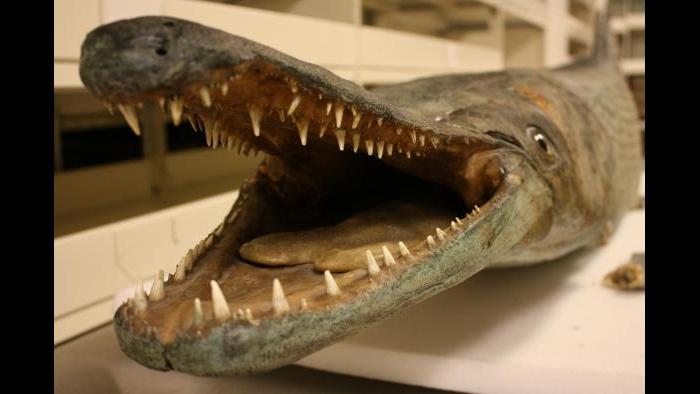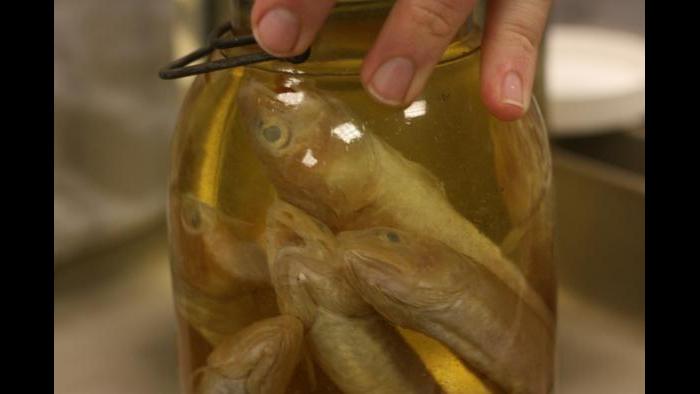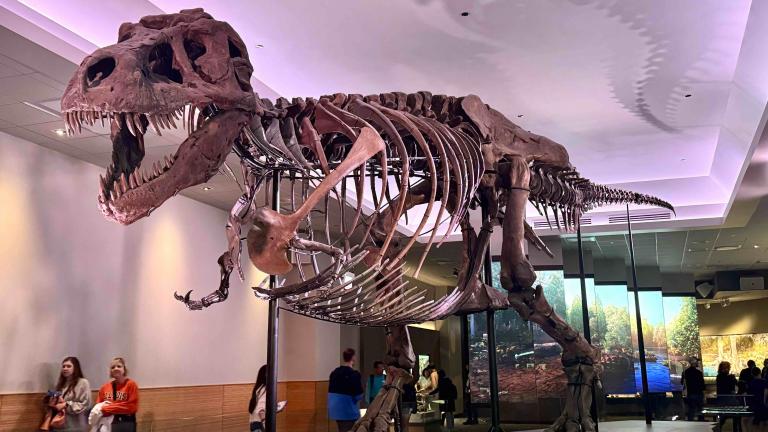A photo of Evarra tlahuacensis, an extinct fish species. The Field Museum houses the only known remaining specimen. (Chloe Riley / Chicago Tonight)
At first glance, the small, brown, formaldehyde-soaked Evarra tlahuacensis doesn’t come off as a terribly striking fish. But the little minnow is actually the only remaining specimen of its kind on Earth – and it's housed at Chicago’s Field Museum. Originally collected just outside Mexico City in 1901 by Seth Meek – one of the museum’s first fish curators – the minnow’s species was ultimately wiped out of existence.
But this particular specimen is not on public display, so we sat down with Field Museum fish scientist Caleb McMahan to get the low-down on the one-of-a-kind minnow.
CHICAGO TONIGHT: Tell us what we’re looking at here. This guy looks like just any average tiny fish you’d find in a pond or lake.
CALEB MCMAHAN: So this jar with this little minnow in it, which looks like just a fairly dried-out, shriveled-up brown fish, is actually, in my opinion, one of the cooler stories in the fish collection. Seth Meek worked all across Mexico and was really one of the earliest people to start doing large-scale collections in that region. And he collected this little minnow in 1901, brought it back and then a year or so later described this as a new species.
This minnow is interesting because it’s a member of a genus of three different minnows, so there’s three species in this group, Evarra. But what’s really interesting about them is, all three are extinct and have been for decades. This is the only specimen of this species. This little brown fish in this jar is our only record that this species ever lived on the planet. So this is one of our really cool stories, albeit sad. But a really interesting part of the fish collection here. So if one’s interested in trying to figure out why this thing went extinct, they would have to come here and look at this specimen to start the quest of figuring it out.
CT: Has anyone attempted to do that yet?
CM: No one has. Likely, one of the main reasons the species died off is, it’s right outside Mexico City, which has grown enormously in population size over the years. So probably a combination of habitat loss and population declines led to extinction of the species. There could be efforts to see what’s around there still, but who knows if this guy would still be there.
Above: The Field Museum's fish collection features some rare breeds.
CT: How is the museum certain that this is the last remaining specimen?
CM: We have our collection database of the specimens we have and then we can search databases at other institutions and other museums. And this is the only known specimen of that species.
CT: Is there a reason the public doesn’t get to see this minnow?
CM: This fish is a part of the research collection. We do use some of these fish in lots of events for the public, but the extinct one is just more difficult to put out.
CT: Does the Field Museum ever lend out fish from its collection?
CM: These specimens get borrowed by folks from all over the world to study and fill in gaps in their projects. We send many, many loans to researchers.
CT: So what happens with the extinct minnow moving forward?
CM: We’re actually working on a project now where we’re going back to Mexico to go to some of these very old localities where these things come from to document what’s changed in this 115-year period of time. There are other species that are still there, but we don’t know how common they are. It’d be interesting to go back to where this [minnow's] from and just compare descriptions and photographs of what it was like when Meek collected this in 1901 versus 2015.
While Evarra tlahuacensis is not on public view, Field Museum members can see the fish on Members’ Night, an annual after-hours event that allows members access to the museum’s labs and private collections.













